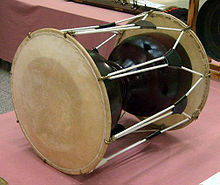Janggu
| Korean spelling | |
|---|---|
| Korean alphabet : | 장구 |
| Hanja : | 杖 鼓 |
| Revised Romanization : | Janggu |
| McCune-Reischauer : | Changgu |
Janggu ( Korean : 장구 ), also changgo, changgu , in older texts also seyogo ("narrow-waisted drum"), is a double-headed drum with an hourglass-shaped body . It is used in all musical styles of Korean music from court music to shamanic ceremonies ( muak ) with the exception of epic chants ( pansori ).
Design
The body is made of paulownia wood, more rarely clay, and is varnished in color. The length varies between 40 and over 60 centimeters, the diameter of the two openings are 20 to over 30 centimeters. The design of the janggu corresponds to the Japanese hourglass drum tsuzumi . The two heads are sewn to metal rings, the diameter of which is almost twice the size of the body openings. The membranes are not firmly connected to the body, but are tied together with cords according to the principle of the South Indian idakka . The player strikes the right side of the drum with a bamboo stick, called ch'ae , and creates a tak sound, with the heel of the left hand creating a kung sound on the left skin .
origin
The janggu , about which little historical information is available, is depicted on a bell from the Silla Empire (57 BC to 935) and on a stone relief from the same period, as well as on a Goguryeo grave (37 BC). to 668). The first manuscript has come down to us from 1076, in which a drum called a janggu is referred to as a folk musical instrument.
For the year 1114 there were reports of twenty janggu that the Chinese Song emperor is said to have given to the Korean Koryo court (918-1392). The janggu is often played in a 6- or 12-bar rhythm pattern ( jangdan ), which is mainly used in peasant folk music (nongak). At the same time it is an important component of court music ( jeong-ak ) and the music of the scholar class ( pungryu ) and is used to accompany the solo instrumental suites sanjo . The janggu should not be confused with the barrel drum buk , which is used to accompany pansori chants. Because of its flexible nature and its mobility with complex rhythms, the janggu still plays the role of a basic accompanying instrument today.
Web links
- Han Song Hiltman: The changgo. Its history and its music. (PDF; 537 kB) University of Hamburg, 2012, pp. 1–15
- Robert C. Provine; Changgo. In: Grove Music Online , April 25, 2019

